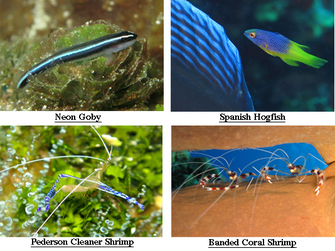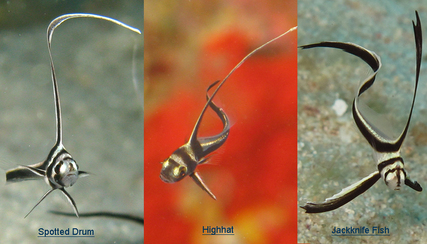 A Tiger Grouper getting cleaned. A Tiger Grouper getting cleaned. Cleaning stations are areas on the reef where the usual rules of predation are suspended, and fish get together for their mutual benefit. Some species of fish, and even shrimps, have evolved to feed on the parasites that can grow on larger fishes. Often working together, these special cleaners will go to work on large carnivores like groupers. Groupers can spend up to eight hours a day getting fussed over at cleaning stations!  Symbiosis is the term used when different species get together to benefit one anonther. Each species will target different cleaning jobs. Neon gobies will feed on tiny parasites, while the tiny Pederson Cleaner Shrimp will actually jump into the mouth of a fish to clean out it's gills. Banded Coral Shrimps have larger claws and are often found cleaning out the larger bits of debris stuck between teeth. All these species and more can be found on one cleaning station, offering a full service!
1 Comment
 Spotted Drums are on of the most iconic reef fishes in the Caribbean, and they are a favorite for underwater photographers. They always stay on the same small patch of the reef, using their elongated dorsal fins to sweep themselves back and forth continuously across their small territory. As juveniles these long dorsal fins will be even longer than their tails. They can be usually be found in groups of two, three or even more individuals. Despite their name, the spotted drum only gets it's spots late in life, starting at the tail and slowly up to the back. The dorsal fins shorten to small, pointed spines as they grow older. The Spotted Drum belongs to the Croaker family, because of the sounds they can sometimes make. Spotted Drum from Caribbean Reef Life on Vimeo.  How to tell them apart: Other members of the Croaker family, such as the Highhat and the Jackknifefish, look almost identical when they are young, and it can be difficult to tell the species apart. The easiest way is to look closely at their snouts (if they will keep still long enough to let you!) The Spotted Drum has a single black spot on it's snout. The Highhat will have a black bar running between it's eyes, and the Jackknife Fish has a black line running down it's nose. The Jackknife can also have a more yellowish tint than it's cousins. Happy hunting! |
Mickey Charteris
Is a Canadian-born South African living in Honduras, who no longer knows where his accent is from. He has been diving all over the world, but has chosen Roatan as his home because of it's incredible underwater biodiversity. He has spent many thousands of hours underwater, and he is still finding something new on every dive. Archives:
February 2014
Categories
All
|
 RSS Feed
RSS Feed